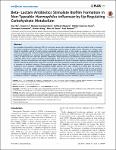Beta-Lactam Antibiotics Stimulate Biofilm Formation in Non-Typeable Haemophilus influenzae by Up-Regulating Carbohydrate Metabolism
Wu, Siva
Li, Xiaojin
Gunawardana, Manjula
Maguire, Kathleen
Guerrero-Given, Debbie
Schaudinn, Christoph
Wang, Charles
Baum, Marc M.
Webster, Paul
Non-typeable Haemophilus influenzae (NTHi) is a common acute otitis media pathogen, with an incidence that is increased by previous antibiotic treatment. NTHi is also an emerging causative agent of other chronic infections in humans, some linked to morbidity, and all of which impose substantial treatment costs. In this study we explore the possibility that antibiotic exposure may stimulate biofilm formation by NTHi bacteria. We discovered that sub-inhibitory concentrations of beta-lactam antibiotic (i.e., amounts that partially inhibit bacterial growth) stimulated the biofilm-forming ability of NTHi strains, an effect that was strain and antibiotic dependent. When exposed to sub-inhibitory concentrations of beta-lactam antibiotics NTHi strains produced tightly packed biofilms with decreased numbers of culturable bacteria but increased biomass. The ratio of protein per unit weight of biofilm decreased as a result of antibiotic exposure. Antibiotic-stimulated biofilms had altered ultrastructure, and genes involved in glycogen production and transporter function were up regulated in response to antibiotic exposure. Down-regulated genes were linked to multiple metabolic processes but not those involved in stress response. Antibiotic-stimulated biofilm bacteria were more resistant to a lethal dose (10 µg/mL) of cefuroxime. Our results suggest that beta-lactam antibiotic exposure may act as a signaling molecule that promotes transformation into the biofilm phenotype. Loss of viable bacteria, increase in biofilm biomass and decreased protein production coupled with a concomitant up-regulation of genes involved with glycogen production might result in a biofilm of sessile, metabolically inactive bacteria sustained by stored glycogen. These biofilms may protect surviving bacteria from subsequent antibiotic challenges, and act as a reservoir of viable bacteria once antibiotic exposure has ended.
Dateien zu dieser Publikation
Keine Lizenzangabe

